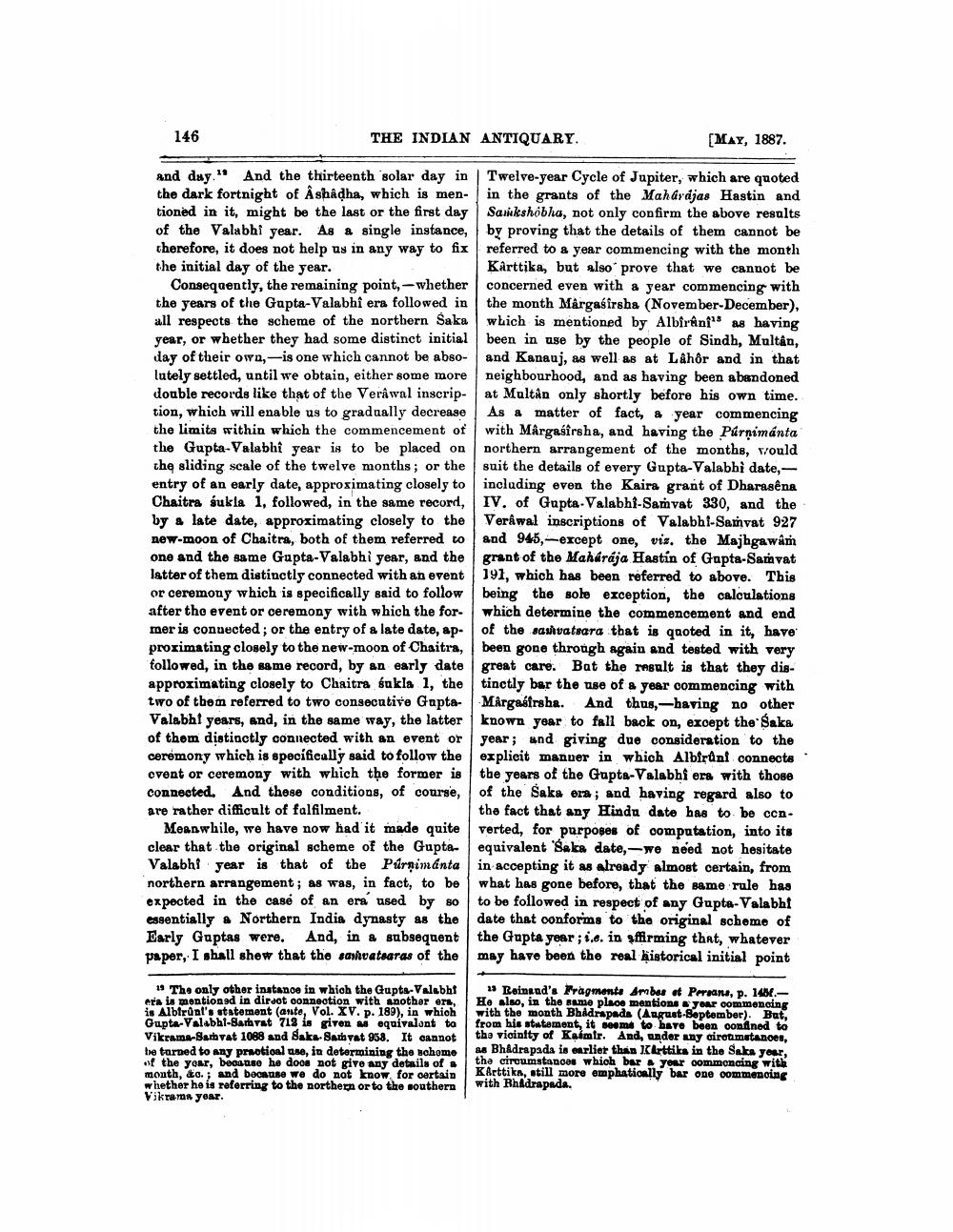________________
146
THE INDIAN ANTIQUARY.
MAY, 1887.
and day." And the thirteenth solar day in Twelve-year Cycle of Jupiter, which are quoted the dark fortnight of Åshadha, which is men- in the grants of the Maharajas Hastin and tioned in it, might be the last or the first day Sasikshobha, not only confirm the above results of the Valabhi year. As a single instance, by proving that the details of them cannot be therefore, it does not help us in any way to fix referred to a year commencing with the month the initial day of the year.
Karttika, but also prove that we cannot be Consequently, the remaining point, whether concerned even with a year commencing with the years of the Gupta-Valabhi era followed in the month Margasirsha (November December), all respects the scheme of the northern Saka which is mentioned by Albireni" as having year, or whether they had some distinct initial been in use by the people of Sindh, Multan, day of their own,-is one which cannot be abso- and Kanauj, as well as at Lâhôr and in that lutely settled, until we obtain, either some more neighbourhood, and as having been abandoned double records like that of the Verawal inscrip- at Multan only shortly before his own time. tion, which will enable us to gradually decrease As a matter of fact, a year commencing the limits within which the commencement of with Margasirsha, and having the Párnimanta the Gupta-Valabhi year is to be placed on northern arrangement of the months, would the sliding scale of the twelve months; or the suit the details of every Gupta-Valabhì date, entry of an early date, approximating closely to including even the Kaira grant of Dharagêna Chaitra sukla 1, followed, in the same record, IV. of Gupta-Valabh-Samvat 330, and the by a late date, approximating closely to the Verâwal inscriptions of Valabhl-Samvat 927 new-moon of Chaitra, both of them referred to and 945, -except one, vix, the Majhgawâm one and the same Gupta-Valabhi year, and the grant of the Maharaja Hastín of Gupta-Samvat latter of them distinctly connected with an event 191, which has been referred to above. This or ceremony which is specifically said to follow being the sole exception, the calculations after the event or ceremony with which the for.which determine the commencement and end mer is connected; or the entry of a late date, ap. of the sashvatsara that is quoted in it, have proximating closely to the new-moon of Chaitra, been gone through again and tested with very followed, in the same record, by an early date great care. Bat the result is that they disapproximating closely to Chaitra sukla 1, the tinctly ber the use of a year commencing with two of them referred to two consecutive Gapta- Mårgasirsha. And thus,-having no other Valabht years, and, in the same way, the latter known year to fall back on, except the Saka of them distinctly connected with an event or year; and giving due consideration to the ceremony which is specifically said to follow the explicit manner in which Albiruni connects event or ceremony with which the former is the years of the Gupta-Valabhi era with those connected. And these conditions, of course, of the Saka ora ; and having regard also to are rather difficult of falfilment.
the fact that any Hindu date has to be conMeanwhile, we have now had it made quite verted, for purposes of computation, into its clear that the original scheme of the Gupta- equivalent Saka date, we need not hesitate Valabhi year is that of the Purnimanta in accepting it as already almost certain, from northern arrangement; as was, in fact, to be what has gone before, that the same rule has expected in the case of an era used by 80 to be followed in respect of any Gupta- Valabhf essentially « Northern India dynasty as the date that oonforms to the original schome of Early Guptas were. And, in a subsequent the Gupta year; ic. in sffirming that, whatever paper, I shall show that the sahvatsaras of the may have been the real Historical initial point
1 The only other instance in which the Gupta-Valabht are in mentioned in dirsot oonnection with another ern, is Albtrunt's statement (ante, Vol. XV. p. 189), in which Gupta-Valabhl-Barkrat 713 is given a equivalent to Vikrama-Sarhvat 1088 and Baka-Bat vat 953. It cannot be tarned to any practical use, in determining the schome of the year, bocase he does not give any details of month, do, and because we do not know for certain whether he is referring to the northern or to the southern Vikrama year.
13 Rainrad's Fragmente ambos et Peruans, p. 1400.He also, in the same place mentions or commencing with the month Bhadrapads (August September). Bet, from his statement, it seems to have been confined to the vicinity of Kaimir. And, ander any cireumatanoes, ss Bhadrapada is earlier than Klettiks in the Sake your, the circumstances which ber . your commencing with Karttika, still more emphationlly bar one oommenoin with Bhadrapada.




